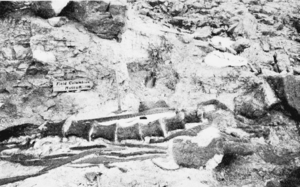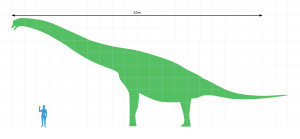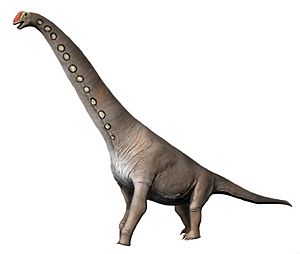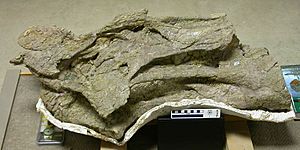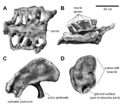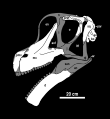Brachiosaurus facts for kids
Quick facts for kids Brachiosaurus |
|
|---|---|
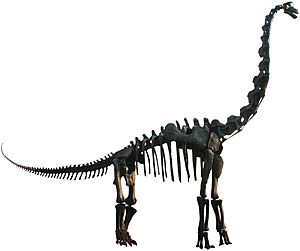 |
|
| Reconstructed replica of the holotype skeleton outside the Field Museum of Natural History | |
| Scientific classification | |
| Genus: |
Brachiosaurus
|
| Species: |
altithorax
|
Brachiosaurus was a giant plant-eating dinosaur. It lived in North America during the Late Jurassic period, about 154 to 150 million years ago. American paleontologist Elmer S. Riggs first described it in 1903. He found its fossils in the Colorado River valley in western Colorado, United States.
Riggs named the dinosaur Brachiosaurus altithorax. The name Brachiosaurus comes from Greek words meaning "arm lizard." This is because its front legs were very long. The second part, altithorax, means "deep chest."
Brachiosaurus was estimated to be between 18 and 22 meters (59 and 72 feet) long. Its body mass could be from 28 to 47 metric tons. That's like many elephants! Like other sauropods, it had a very long neck, a small head, and a huge body. But Brachiosaurus was special because its front legs were longer than its back legs. This made its body slope steeply upwards. It also had a shorter tail compared to other sauropods.
Brachiosaurus is the name for a group of similar dinosaurs called Brachiosauridae. Many pictures of Brachiosaurus you see are actually based on Giraffatitan. This dinosaur lived in Tanzania, Africa. Giraffatitan was once thought to be a type of Brachiosaurus. But in 2009, scientists decided it was its own genus. Brachiosaurus is one of the most famous dinosaurs. It appeared in the 1993 movie Jurassic Park.
Contents
How We Found Brachiosaurus
The first Brachiosaurus skeleton was found in 1900. It was discovered in the Colorado River valley near Fruita, Colorado. This special fossil became the "holotype" specimen. It came from rocks that are about 154 to 153 million years old.
Elmer S. Riggs and his team from the Field Museum of Natural History in Chicago found it. A local dentist, Stanton Merill Bradbury, told Riggs about dinosaur bones in the area. Riggs was unsure at first. But his boss wanted a big dinosaur skeleton for the museum. So, they funded an expedition.
The team set up camp in June 1900. On July 4th, Riggs's assistant, Harold William Menke, found a huge arm bone. He shouted, "the biggest thing yet!" Riggs realized they had found the largest land animal known at that time.
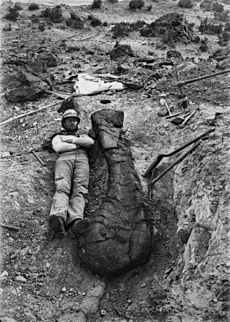
The place where they found the bones is now called Riggs Hill. It even has a plaque. More Brachiosaurus fossils are still there.
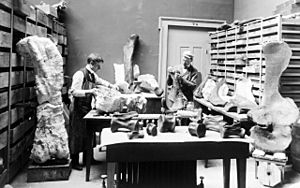
Riggs wrote a short report in 1901. He noted the unusual length of the arm bone compared to the leg bone. He also saw its huge size and giraffe-like shape. In 1903, he officially named it Brachiosaurus altithorax. Riggs chose the name "arm lizard" because of its long arms. The "deep chest" part came from its very deep and wide chest. Riggs's early articles proudly called it the "largest known dinosaur." He published a more detailed description in 1904.
What Brachiosaurus Looked Like
Its Size
Scientists estimate Brachiosaurus was about 20–22 meters (66–72 feet) long. It could stand as tall as 9.4 to 13 meters (31 to 43 feet). Imagine a building that tall!
Body Shape
Like all sauropods, Brachiosaurus walked on four legs. It had a small head, a very long neck, and a large body. Its tail was long and muscular, and its legs were like strong columns. Inside its body, it had large air sacs connected to its lungs. These helped it breathe.
The neck of Brachiosaurus was incredibly long. It probably had thirteen long neck bones, similar to its close relative Giraffatitan. The neck likely curved a bit like an "S" shape.
Brachiosaurus had different body parts compared to Giraffatitan. Its body was about 25 to 30 percent longer. This meant its back bone was longer than its arm bone. Only one complete tail bone has been found. But its size suggests the tail was bigger than Giraffatitan's.
Unlike Giraffatitan, the front legs of Brachiosaurus seemed to spread out a little at the shoulders. Its arm bone was not as thin as Giraffatitans. This might mean Brachiosauruss front legs carried more of its body weight.
How Brachiosaurus Lived
For a long time, people thought huge dinosaurs like Brachiosaurus were too heavy to live on land. They believed these dinosaurs lived partly in water. But Elmer S. Riggs showed in 1904 that most sauropods lived entirely on land. He pointed out that their hollow bones were not like those of water animals. Their long legs and strong feet were perfect for walking on the ground. Brachiosaurus was especially good at living on land. It had slender legs, a high chest, wide hips, and a short tail. Some scientists in 1990 suggested Brachiosaurus might have gone into water sometimes to cool off.
Neck Position
Scientists still debate how brachiosaurids held their necks. Some think it was almost straight up, while others think it was more horizontal. Until 1999, many believed sauropods held their necks upright. But then, some research suggested the neck wasn't flexible enough for a full S-curve.
However, museum scientists defended the upright posture for Brachiosaurus. They noted its long front limbs and upward-sloping backbone. They also said that strong muscles in the shoulder area would have allowed a giraffe-like neck position. Holding its neck up might have used less energy than lowering it. Also, the neck bones might not have handled the pressure of a lowered head for long periods. Some recent studies also support a more upward neck position.
With their heads held high, brachiosaurids would have needed a strong heart. It's thought that a Brachiosaurus's heart would need to pump blood with twice the pressure of a giraffe's. It might have weighed 400 kg (880 pounds). The S-curve of the neck would have shortened the distance between the head and heart. This would make it easier for the heart to pump blood.
What It Ate
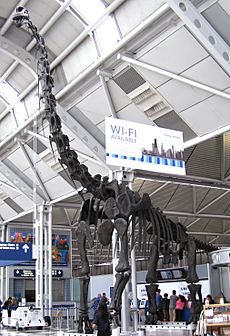
Brachiosaurus was likely a "high browser." This means it ate leaves and branches from tall trees. Even if its neck wasn't held straight up, its head could still reach over 9 meters (30 feet) high. It probably ate most of its food from trees taller than 5 meters (16 feet). Its diet likely included ginkgos, conifers, tree ferns, and large cycads. One study from 2007 estimated it ate 200 to 400 kg (440 to 880 pounds) of plants every day.
Brachiosaurus ate by moving its jaw up and down. Like other sauropods, it swallowed plants without much chewing. It relied on its gut to break down the food. Its teeth were spoon-shaped and chisel-like. These teeth were good for nipping off large amounts of plant material.
A 40-ton Brachiosaurus would need to eat about half a ton of food daily. If it fed for 16 hours a day, taking many bites per minute, its food intake would be about 1.5 percent of its body weight. This is similar to what a modern elephant eats.
Some scientists think Brachiosaurus could stand on its back legs to reach even higher branches. It might have used its tail for balance. This two-legged stance might also have been used in rare situations, like fights between males. Its neck could also bend down to reach water on the ground.
Breathing System
The breathing system of sauropods, like Brachiosaurus, was similar to birds. It used air sacs. Unlike mammals, air didn't just go in and out of the lungs. Instead, air was sucked from the windpipe into an air sac in the belly. This sac then pushed the air forward through the lungs. Other air sacs helped move the used air out. This system made sure air always flowed in one direction through the lungs. This greatly improved how much oxygen it took in and how much carbon dioxide it released.
Brachiosaurus in Pop Culture
Brachiosaurus is known as one of the most famous dinosaurs. But many popular images are actually of Giraffatitan. An asteroid in space was even named 9954 Brachiosaurus in 1991!
Brachiosaurus became very famous after the 1993 movie Jurassic Park. It was the first dinosaur shown in the movie using computer graphics. These effects were amazing at the time. The characters' wonder when they saw the dinosaur was felt by audiences too. The way the Brachiosaurus moved in the movie was based on how a giraffe walks, combined with an elephant's heavy steps. Later in the movie, a robot Brachiosaurus head and neck were used for close-up scenes with human characters. The computer model of Brachiosaurus from Jurassic Park was even used to create the "ronto" creatures in the 1997 special edition of Star Wars Episode IV: A New Hope.
Images for kids
-
O. C. Marsh's outdated 1891 skeletal reconstruction of Brontosaurus, with skull inaccurately based on that of the Felch Quarry Brachiosaurus
-
Scapulocoracoid BYU 9462 has been seen as a possible Brachiosaurus bone; it was originally assigned to Ultrasauros (now a junior synonym of Supersaurus), Museum of Ancient Life
-
Referred forelimb bone (humerus) from Potter Creek, USNM 21903
-
Skeleton of Giraffatitan, formerly B. brancai, Natural History Museum, Berlin
-
Vertebral anatomy of the holotype skeleton. Top: sixth dorsal vertebra in back (A) and right side view (B). Bottom: second caudal vertebra in back (C) and side view (D).
-
Reconstruction of the Felch Quarry Brachiosaurus skull, Denver Museum of Nature & Science
-
Juvenile B. sp. specimen SMA 0009, nicknamed Toni. The skull is reconstructed following the initial diplodocoid identification), Sauriermuseum Aathal.
See also
 In Spanish: Brachiosaurus altithorax para niños
In Spanish: Brachiosaurus altithorax para niños


